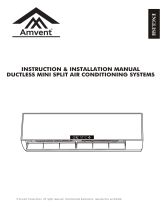
En-1
AIR CONDITIONER (COMPACT CASSETTE TYPE)
OPERATING MANUAL
PARTS No. 9374379989
SAFETY PRECAUTIONS
●
Do not attempt to install this air conditioner by yourself.
●
This unit contains no user-serviceable parts. Always consult authorized service per-
sonnel for repairs.
●
When moving, consult authorized service personnel for disconnection and installa-
tion of the air conditioner.
●
Do not become excessively chilled by staying for many hours in the direct cooling airfl ow
.
●
Do not insert fi ngers or objects into the outlet port or intake grilles.
●
Do not start and stop air conditioner operation by turning off the electrical breaker
.
●
Take care not to damage the power supply cable.
●
If the power supply cable of this appliance is damaged, it should only be replaced by the
authorized service personal, since special purpose tools and specifi ed cable are required.
●
In the event of a malfunction (burning smell, etc.), immediately stop operation, turn
off the electrical breaker, and consult authorized service personnel.
●
In the event of refrigerant leakage, be sure to keep away from fi re or any fl amma-
bles. (consult an authorized service personnel)
●
Provide occasional ventilation during use.
●
Do not direct airfl ow at fi replaces or heating apparatus.
●
Do not climb on, or place objects on, the air conditioner.
●
Do not hang objects from the indoor unit.
●
Do not set fl ower vases or water containers on top of air conditioners.
●
Do not expose the air conditioner directly to water.
●
Do not operate the air conditioner with wet hands.
●
Do not pull power supply cable.
●
Turn off power source when not using the unit for extended periods.
●
Always turn off the electrical breaker whenever cleaning the air conditioner or changing the air fi lter.
●
Connection valves become hot during Heating; handle with care.
●
Check the condition of the installation stand for damage.
●
Do not place animals or plants in the direct path of the airfl ow.
●
When restarting after a long period of disuse in the winter, turn the power switch on
at least 12 hours before starting the unit.
●
Do not drink the water drained from the air conditioner.
●
Do not use in applications involving the storage of foods, plants or animals, preci-
sion equipment, or art works.
●
Do not apply any heavy pressure to radiator fi ns.
●
Operate only with air fi lters installed.
●
Do not block or cover the intake grille and outlet port.
●
Ensure that any electronic equipment is at least 40 in (1m) away from either the in-
door or outdoor units.
●
Avoid installing the air conditioner near a fi replace or other heating apparatus.
●
When installing the indoor and outdoor units, take precautions to prevent access by infants
.
●
Do not use infl ammable gases near the air conditioner.
●
Install the drain hose so that it drains water properly.
●
This appliance is not intended for use by persons (including children) with reduced
physical, sensory or mental capabilities, or lack of experience and knowledge, un-
less they have been given supervision or instruction concerning use of the appli-
ance by a person responsible for their safety. Children should be supervised to en-
sure that they do not play with the appliance.
CAUTION!
●
Before using the appliance, read these “SAFETY PRECAUTIONS” thoroughly and operate in the correct way.
●
The instructions in this section all relate to safety; be sure to maintain safe operating conditions.
●
“WARNING” and “CAUTION” have the following meanings in these instructions:
WARNING!
This mark indicates procedures which, if improperly performed, might lead to the
death or serious injury of the user or service personnel.
CAUTION!
This mark indicates procedures which, if improperly performed, might possibly re-
sult in personal harm to the user or damage to property.
WARNING!
CONTENTS
SAFETY PRECAUTIONS ........................................ 1
FEATURES AND FUNCTIONS ............................... 2
NAME OF PARTS ................................................... 3
PREPARATORY OPERATION ................................ 4
OPERATION ............................................................ 4
TIMER FUNCTIONS ............................................... 6
ON/OFF TIMER ....................................................... 6
WEEKLY TIMER ...................................................... 7
TEMPERATURE SET BACK TIMER ....................... 9
ADJUSTING THE DIRECTION OF AIR CIRCULATION
... 10
SWING OPERATION ............................................ 10
ECONOMY OPERATION .......................................11
MANUAL AUTO OPERATION ................................11
CLEANING AND CARE ..........................................11
TROUBLESHOOTING .......................................... 13
TROUBLESHOOTING .......................................... 14
SELF-DIAGNOSIS ................................................ 16























